8 December, 2002
8 December, 2002
Lots of news on many fronts:
Ice tank detector: Bai & I replaced the suspicious connector in the
tank today. But after a lot more tests, the PMTs were clearly not
behaving well. This is perplexing and frustrating, and we are
beginning to suspect that they may have been damaged by thermal
expansion when we first opened the tank lid and let them warm up. We
heard a couple of "pops," but attributed those noises to the
expansion of the ice.
Bai explained the whole situation to his colleagues by email last
night, and is hoping for some fresh ideas. We are looking at possibly
opening up the tank tomorrow and doing a visual inspection of the
PMTs, which sit inside acrylic spheres. This may require opening up
the spheres, which may require hacksawing the threaded rod which
holds them together. But Bai's main PMT expert failed to understand
the situation, in his email reply, so we're awaiting clarification.
Funny note: the expert is in Washington, DC, and offered to come over
to check the problem first hand! He thought Bai was in Delaware! (Bai
works for the Bartol Research Institute, which is associated with the
University of Delaware in Newark)
To find out more about cosmic rays :
http://www.invisiblemoose.net/site_material/WALTA/walta.html
Kites: Got flying today! What I learned :
a) wind is much better aloft than at the surface, even though there's
not many trees or hills here.
b) To lift the camera rig, both kites I brought are required. Using a
caribiner, I improvised a second hitch for the smaller kite, and that
provided enough force to get the rig up.
c) The camera is good for about 15 minutes in the cold. Ditto for the
batteries that drive the servos.
d) The camera needs to go higher, and shoot with a wide field of
view. Our main subject was the ice tank pit, and I got shots all
around it, but not in it.
e) Kites make people nervous around here, with all the air traffic.
Weekends are best. Flights stopped Saturday at noon, and will resume
Sunday morning.
f) Station folks have been very accommodating and helpful.
g) Kites are a great way to meet people.
To find out more about kite aerial photography :
http://www.invisiblemoose.net/site_material/KAP/KAP.html
Portable detector: The solar experiment I ran yesterday? I expected
that since the count rate went down, the AIR PRESSURE went up. More
air over your detector blocks more parcticles. I checked with
meteorology, and the pressure went DOWN during that interval!
Read specs on the PMTs. They have an operating minimum of +5 C ! So
what the solar experiment may be showing is the PMTs cooling down to
ambient outside temperature (-30 C)
So I brought them inside the SPASE shack, and ran a long experiment,
and indeed, count rates climbed as they warmed up.
I also repeated the shielding experiment, and the results seem to
indicate that the shielding lowered counts. Tomorrow : a spacing
experiment.
To find out more about the portable detector :
http://www.invisiblemoose.net/site_material/Matis_detector/MatisMuhs.html

A little bit more wind, and Voila! The kite is flying for the first time at -35 degrees. The kite is a Sutton Flowform 30. No spars, just unroll it and shake it out and fill it with wind...

The kite is flying ! Hooray ! I was worried about the high altitude: there's just not as much air pushing things around at 10,500 feet, and I was afraid it would be difficult to get the kite up.
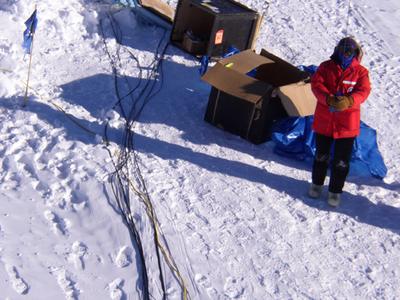
This is Bai, holding the kite string. We tried to get some aerial pictures of the tank & pit where we've been working, but were unsuccessful. To get the camera lofted at all, I had to improvise a tandem rig using both kites to provide more lift. Lessons : a) camera has useful lifetime of about 15 minutes in the cold. B) get camera up higher, take a wider field of view, and crop the picture later.
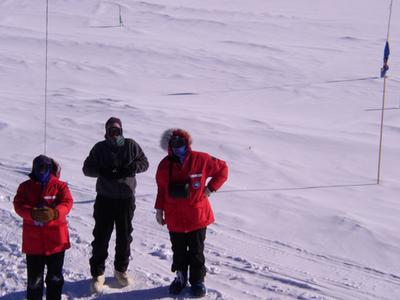
This is an aerial shot of Phillipe Herquet, Bai Xinhua, and myself, near the tank pit. Hello !
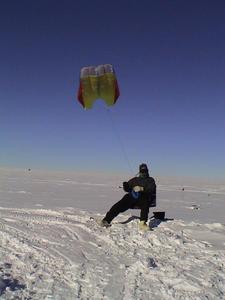
After a hard day of work at the South Pole, I like to relax with a kite and my favorite easy chair...
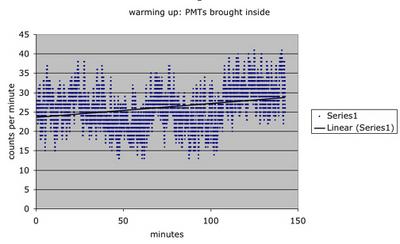
After reading that the PMTs in my portable detector have, according to the manufacturer's specs, an operating temperature range minimum of + 5 C, I thought I'd try bringing them in from -30 C (!) and watch the count rate go up. It did. This can explain some conflicting data I've collected earlier. If the PMTs haven't reached equilibrium (in other words, they're still cooling down) when I'm running an outside experiment, this issue will confound any real data I take.
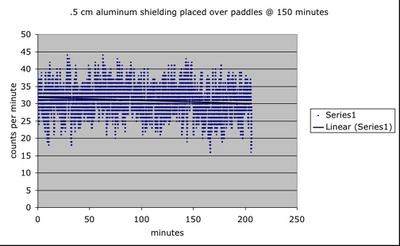
Does placing a 1/2 cm slab of aluminum on top of the detectors change the count rate ? These detectors were inside the SPASE shack, and at room temperature, and the metal slab was placed on top at 150 minutes. A slight decrease, yes ?
Contact the TEA in the field at
.
If you cannot connect through your browser, copy the
TEA's e-mail address in the "To:" line of
your favorite e-mail package.
|
